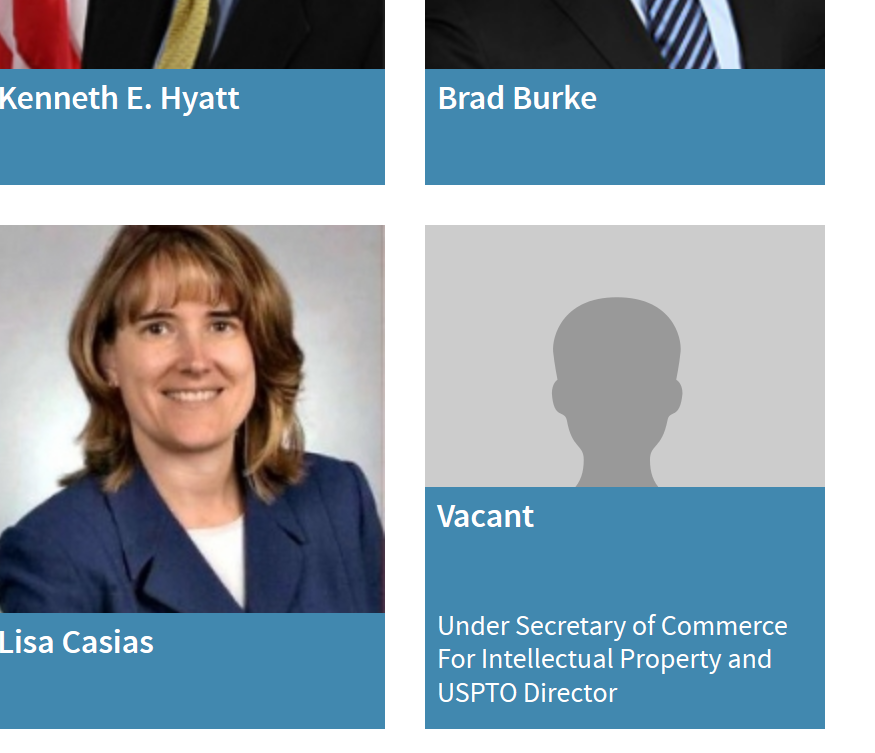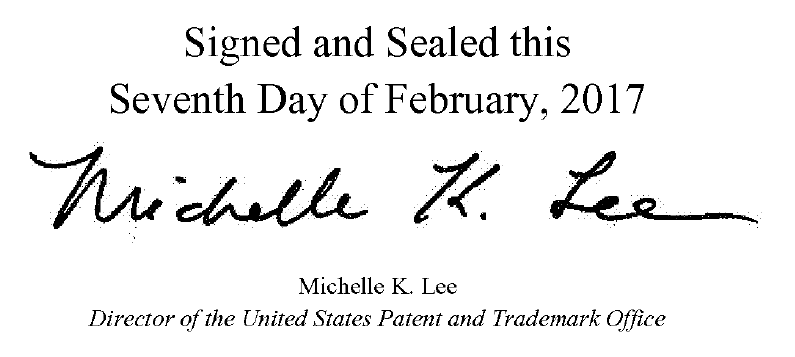 It’s that time of year again. The time of year when it is important to keep track of the fact that Daylight Saving Time is different in Switzerland from the way it is in the United States. This is important because you might be in the US, and you might be e-filing (or fax-filing) some document with the International Bureau of WIPO. Continue reading “Filing at the International Bureau and Daylight Saving Time”
It’s that time of year again. The time of year when it is important to keep track of the fact that Daylight Saving Time is different in Switzerland from the way it is in the United States. This is important because you might be in the US, and you might be e-filing (or fax-filing) some document with the International Bureau of WIPO. Continue reading “Filing at the International Bureau and Daylight Saving Time”
Who is the Director of the USPTO?
 As I mentioned a couple of days ago, by statute, any issued US patent or US trademark registration must be “signed by the Director”. So the question “who is the Director?” is not an idle question.
As I mentioned a couple of days ago, by statute, any issued US patent or US trademark registration must be “signed by the Director”. So the question “who is the Director?” is not an idle question.
As of today (screen shot at right), the Department of Commerce web site still lists the position of Director as “vacant”.
Yesterday’s issued US patents and US trademark registrations bore Michelle Lee’s signature, just as on Tuesdays before.
Patents and trademark registrations “shall be signed by the Director”
 (Corrected thanks to David Boundy, as to which Director succeeded which.)
(Corrected thanks to David Boundy, as to which Director succeeded which.)
Normally the statutory requirement that a patent issued by the USPTO, or a trademark registration certificate issued by the USPTO, “shall be signed by the Director” (35 U.S. Code § 153 and 15 U.S. Code § 1057) is sort of boring. But just now, the USPTO expressly refuses to say who is the Director of the USPTO. What does this mean for patents and trademark registrations that have issued on recent Tuesdays? Continue reading “Patents and trademark registrations “shall be signed by the Director””
Would you like to attend the E-Trademarks reception in Barcelona?
 Will you be in Barcelona this May at the time of the annual meeting of the International Trademark Association? If so, maybe you would like to rub elbows with the savvy and alert people who belong to the E-Trademarks Listserv. Maybe you would like to attend the Seventh Annual E-Trademarks Listserv reception. To attend the reception you will need to have one of these spiffy ribbons (see at right) attached to your meeting badge. To receive one of these spiffy ribbons, just scan the QR code in the ribbon. Or you can click here.
Will you be in Barcelona this May at the time of the annual meeting of the International Trademark Association? If so, maybe you would like to rub elbows with the savvy and alert people who belong to the E-Trademarks Listserv. Maybe you would like to attend the Seventh Annual E-Trademarks Listserv reception. To attend the reception you will need to have one of these spiffy ribbons (see at right) attached to your meeting badge. To receive one of these spiffy ribbons, just scan the QR code in the ribbon. Or you can click here.
Tomorrow will be a federal holiday
In the EFS-Web listserv, alert listserv member Michele Cimbala points out that tomorrow will be a federal holiday in the District of Columbia for purposes of filings at the USPTO.
You can see this on the USPTO web site.
Anything that was due to be filed tomorrow, January 20, 2017 will be timely if filed the following Monday, January 23, 2017.
USPTO tackling the “balaclava problem” (part 2)
In the previous blog article I described the “balaclava problem” and gave an example of a real-life trademark application presenting this problem. In that blog article I described one of the two ways that the USPTO is trying to attack the “balaclava problem”. In this blog article I describe a second way that the USPTO is trying to attack this problem.
Continue reading “USPTO tackling the “balaclava problem” (part 2)”
USPTO tackling the “balaclava problem” (part 1)
Trademark filers are familiar with the “balaclava problem”. When I say the “balaclava problem” I mean the many US trademark registrations in which the listing of identified goods or services in a particular trademark class is a listing of all possible goods or services in that class. The USPTO has launched two recent initiatives which are intended to try to fight the “balaclava problem”. This blog article discusses one of the initiatives and the next blog article discusses the second of the initiatives.
Let’s first give a real-life illustration of the “balaclava problem”. As an example consider the 721 items of goods in class 25 (clothing) for this application, which is presently pending before the USPTO: Continue reading “USPTO tackling the “balaclava problem” (part 1)”
First results from USPTO’s Trademark Application Docket system
 I’ve received my first status monitoring results from USPTO’s new TAD (Trademark Application Docket) system. The system worked, so far as I can tell. I’ll describe how it went. Continue reading “First results from USPTO’s Trademark Application Docket system”
I’ve received my first status monitoring results from USPTO’s new TAD (Trademark Application Docket) system. The system worked, so far as I can tell. I’ll describe how it went. Continue reading “First results from USPTO’s Trademark Application Docket system”
A new way to monitor the trademark Official Gazette
 The USPTO has quietly released a new way to monitor the trademark Official Gazette. (Note that this is not at all the same thing as the trademark application monitoring system that I discussed in the previous blog article! This blog article is talking about a system for monitoring the Official Gazette, and the previous blog article is talking about a system for monitoring TSDR.)
The USPTO has quietly released a new way to monitor the trademark Official Gazette. (Note that this is not at all the same thing as the trademark application monitoring system that I discussed in the previous blog article! This blog article is talking about a system for monitoring the Official Gazette, and the previous blog article is talking about a system for monitoring TSDR.)
Continue reading “A new way to monitor the trademark Official Gazette”
A new way to monitor US trademark filings
![]() The USPTO has quietly rolled out a new system that permits users to monitor the status of trademark filings. The USPTO’s new system has a few features in common with Feathers!, the well-known software for monitoring US trademark filings. I hope trademark practitioners will give the USPTO’s new system a try and post comments below, to report their experience.
The USPTO has quietly rolled out a new system that permits users to monitor the status of trademark filings. The USPTO’s new system has a few features in common with Feathers!, the well-known software for monitoring US trademark filings. I hope trademark practitioners will give the USPTO’s new system a try and post comments below, to report their experience.
Continue reading “A new way to monitor US trademark filings”
